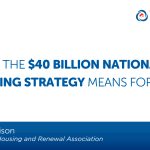What the $40 Billion National Housing Strategy Means for You4 min read
Reading Time: 3 minutesAffordable housing becomes more of an issue every year.
In Canada, $40 Billion has been allocated to the community housing sector.
But how is that money being spent?
In our inaugural episode, we sat down with Jeff Morrison, Executive Director at the Canadian Housing and Renewal Association, to find out.
Jeff covered:
- How the affordable housing sector is changing
- What the National Housing Strategy means for you
- How COVID-19 is changing the housing market
Affordable housing today
Community housing is changing in Canada.
And that’s big news for those living in the roughly 600,000 nonprofit units across the country.
Jeff has seen the government step up and become re-engaged and housing providers start to really transform their operations.
“It’s an interesting time in this community housing sector. There’s a lot of changes — and change brings opportunity.” — Jeff Morrison
Still, much of the existing community housing across the country was built between the 60s and 80s and is in dire need of repair.
That’s what is really keeping housing providers awake at night — well, that and keeping low rent-rates below market level.
These are the key challenges faced in an industry going through a period of upheaval.
That’s the bad news.
The good news is that the government has approved a $40 billion National Housing Strategy, which seeks to address these issues.
That expenditure is funding many much-needed projects to rejuvenate the sector.
But like any government spending, it can get kind of confusing.
So, let’s break it down…
What does $40 billion buy?
The flagship program tackling affordable housing in Canada is the National Co-Investment Fund.
This is a $14 billion program designed to provide housing providers with loans and grants to build new units and repair existing ones over the next 8 years.
There was also an announcement of a 10-year extension to federal and provincial programs that provide rent subsidies directly to housing providers.
On top of the spending, Canada is also taking the lead on legislation ensuring a right to housing, which removes any federal barriers to housing access.
The goal is to cut homelessness by half over the next few years.
“The right to housing will essentially establish a whole bunch of mechanisms that will ensure that there are no federal barriers to accessing housing.” — Jeff Morrison
By 2028, additional money will be added into research and a program called the Community Housing Transformation Fund.
This program will give housing providers access to funds enabling them to transform their operations.
These various programs should help ensure that suppliers will also have the opportunity to better engage and partner with housing providers, spurring more innovation and change in the sector.
Still, the $40 billion package is not a long-term solution, but it will make a difference over the next several years.
Of course, the world has thrown a curveball in the form of a global pandemic.
So, how will the sector fair in the face of these new challenges?
What COVID-19 means for community housing
It seems odd to say given the past few months, but we’re still in the early stages of the pandemic. Nobody knows the longterm economic effects yet with any real precision.
But one might reasonably expect that, given the economic downturn accompanying the pandemic, that demand is only going to go up for community housing.
“The biggest challenge is supply, supply, supply. The demand is huge.” — Jeff Morrison
Well, even without a pandemic, that was already a sure bet.
The demand for affordable housing continues to rise, year-after-year, which is why the government programs are so vital.
Access to affordable housing is a huge problem.
And if we plan to tackle it, we’re going to need every tool we’ve mentioned thus far and then some.
For their part, the CMHC — Canada’s federal housing department — have established the laudable goal of ensuring every Canadian has access to affordable housing by 2030.
Of course, for that to succeed, there needs to be involvement from organizations of all shapes and sizes across the landscape.
There needs to be private sector involvement, municipal, provincial, territorial and federal involvement — and of all these will need to communicate and cooperate in order to meet these goals.
And for Jeff and the Housing and Renewal Association, facilitating these relationships, aiding innovation and fostering creative approaches to financing is the main focus in the coming years.
This post is based on a Business Optimization podcast with Jeff Morrison. The views, information, or opinions expressed during the podcast series are solely those of the individuals involved and do not necessarily represent those of Reliance Home Comfort and its team members.
To hear this episode, and many more like it, you can subscribe to Business Optimization here. If you don’t use Apple, you can find us here.



